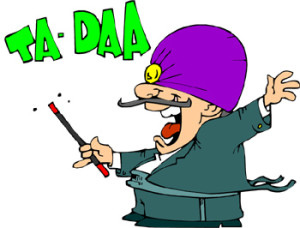 It’s time to give away the most important trick in the book when it comes to crafting a great interactive presentation. As I said in earlier posts, it doesn’t really matter what opening activity you use to launch your presentation. The key to success lies in how you process that activity directing people to discover the point you’re making. This is called debriefing. There’s a simple acronym that might help you as we go through the debriefing process. It’s this…
It’s time to give away the most important trick in the book when it comes to crafting a great interactive presentation. As I said in earlier posts, it doesn’t really matter what opening activity you use to launch your presentation. The key to success lies in how you process that activity directing people to discover the point you’re making. This is called debriefing. There’s a simple acronym that might help you as we go through the debriefing process. It’s this…
- Do
- Reflect
- Analyze
- Generalize
The activity covers the Do part of D.R.A.G. Once you’ve done the activity you want to get your participants into small discussion groups. No more than eight to a group is best, though I prefer six as the best size. Let’s pause a moment and highlight the small group component of this. One mistake often made by those unfamiliar with leading an interactive presentation is to process the activity in large group. While this may feel like it gives you control of the room, it actually stifles participation and limits the effectiveness of the debriefing. It is crucial that you do the debriefing in small groups. You tell them the questions to process but let them do it in their groups. Which takes me back to D.R.A.G.
The Reflect part is just that. It’s a review of what you just did. This is characterized by questions like, ‘How did you feel about this activity?’ and ‘What was your strategy for succeeding at this game?’ These questions help people make a technical analysis of the activity itself. This is important because the way they think about the game and how they engaged in it is a direct reflection of personality types, ethics, values and more. By answering the technical reflection questions the participants are revealing much more about themselves than they realize.
The Analyze part is still related fairly closely to the activity. Now you get into ‘why’ questions like, ‘Why did you decide on that approach to the game?’ and ‘Why do you think your strategy worked/didn’t work?’ This allows them to consider strengths and weaknesses in the planning and execution process. Again, the game is nonsense, but the way they approach the game provides some wonderful insights that you will use later.
Finally, the Generalize part is where you make broader applications. This phase is where the money is. This is where you turn their focus to your topic very overtly. Questions in this phase are comparative. Something like this, ‘How is this activity like launching a new product line?’ and ‘How is this activity different from our sales process?.’ It is during the generalize portion when the light bulbs begin to go on. People start making the connections between the activity, their behaviors and the point of your presentation. It’s in the generalize portion when you’ll get some of the best information you’ll use to highlight and emphasize your point. And it’s what makes your point powerful because they have discovered and discussed it on their own with everyone engaged in the process.
Tomorrow’s post will be a full debriefing script to follow the Three Wise Monkeys activity as a way of showing how this works.
Leave a Reply